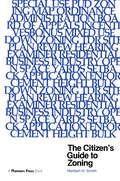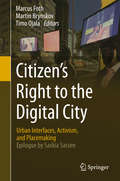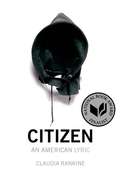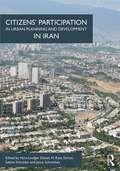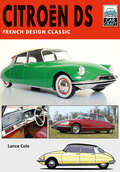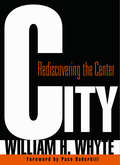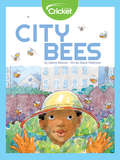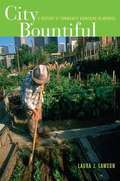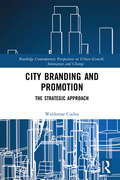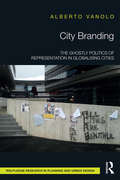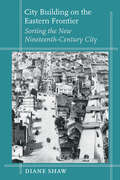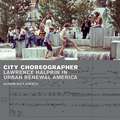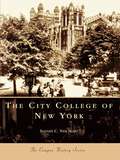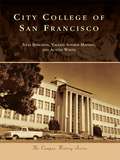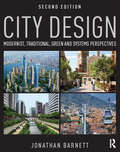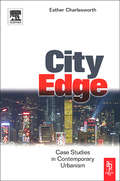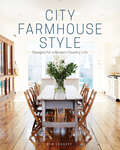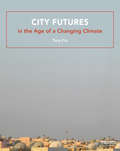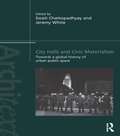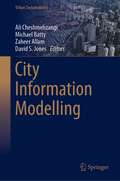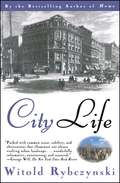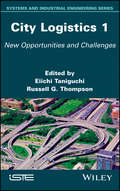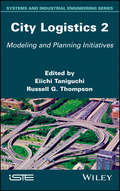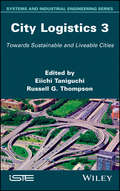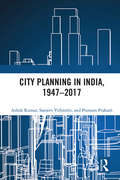- Table View
- List View
Citizen's Guide to Zoning
by Herbert SmithFirst published in 1983. Routledge is an imprint of Taylor & Francis, an informa company. An easy-to-read book about zoning that cuts the jargon out but leaves the wisdom in. Smith explains the fundamental principles of zoning, how to develop zoning regulations, and the nuts and bolts of a zoning ordinance. He examines variances, zoning hearings, and frequent zoning problems.
Citizen's Right to the Digital City: Urban Interfaces, Activism, and Placemaking
by Marcus Foth Martin Brynskov Timo OjalaEdited by thought leaders in the fields of urban informatics and urban interaction design, this book brings together case studies and examples from around the world to discuss the role that urban interfaces, citizen action, and city making play in the quest to create and maintain not only secure and resilient, but productive, sustainable and viable urban environments. The book debates the impact of these trends on theory, policy and practice. The individual chapters are based on blind peer reviewed contributions by leading researchers working at the intersection of the social / cultural, technical / digital, and physical / spatial domains of urbanism scholarship. The book will appeal not only to researchers and students, but also to a vast number of practitioners in the private and public sector interested in accessible content that clearly and rigorously analyses the potential offered by urban interfaces, mobile technology, and location-based services in the context of engaging people with open, smart and participatory urban environments.
Citizen: An American Lyric
by Claudia Rankine* Finalist for the National Book Award in Poetry ** Winner of the National Book Critics Circle Award in Poetry * Finalist for the National Book Critics Circle Award in Criticism * Winner of the NAACP Image Award * Winner of the L.A. Times Book Prize * Winner of the PEN Open Book Award *ONE OF THE BEST BOOKS OF THE YEAR:The New Yorker, Boston Globe, The Atlantic, BuzzFeed, NPR. Los Angeles Times, Publishers Weekly, Slate, Time Out New York, Vulture, Refinery 29, and many more . . .A provocative meditation on race, Claudia Rankine's long-awaited follow up to her groundbreaking book Don't Let Me Be Lonely: An American Lyric.Claudia Rankine's bold new book recounts mounting racial aggressions in ongoing encounters in twenty-first-century daily life and in the media. Some of these encounters are slights, seeming slips of the tongue, and some are intentional offensives in the classroom, at the supermarket, at home, on the tennis court with Serena Williams and the soccer field with Zinedine Zidane, online, on TV-everywhere, all the time. The accumulative stresses come to bear on a person's ability to speak, perform, and stay alive. Our addressability is tied to the state of our belonging, Rankine argues, as are our assumptions and expectations of citizenship. In essay, image, and poetry, Citizen is a powerful testament to the individual and collective effects of racism in our contemporary, often named "post-race" society.
Citizens' Participation in Urban Planning and Development in Iran
by M. Reza Shirazi Hans-Liudger Dienel Sabine Schröder Jenny SchmithalsDuring recent years, the topic of participation has increasingly been gaining importance in Iran – in the scientific field, in practice and rhetoric. However, in current scientific literature – and especially in English literature – there is little knowledge on the conditions, legal background, perceptions, experiences and processes of citizens’ participation in Iran. This book aims to shed light on the paradoxical question of participation in Iran: it is old and new, dysfunctioning and functioning, disappointing and promising. This slippery status of participation convinces scholars to suggest contradictory interpretations and understandings about the existence, functionality, and potentiality of this concept. The book therefore shows the different perspectives, interpretations, historical developments and case studies of participation in Iran, thus giving the reader a kaleidoscope view on the question of participation in Iran.
Citroën DS: French Design Classic (Car Craft)
by Lance ColeLaunched in 1955 yet looking like a sci-fi design proposal for a future then undreamed of, Flaminio Bertoni's ellipsoid sculpture with wheels that was the Citroën DS stunned the world. There was a near riot at the 1955 Paris Motor Show launch of the car, orders flooded in for this, the new 'big Citroën' (a Voiture a Grande Diffusion or VGD) as the car that replaced the legendary Traction Avant range. The term 'DS' stems from two Citroën parts of nomenclature - the type of engine used as the 11D, (D) and the special hemispherical design of the cylinder head as 'Culasse Special' (S): DS out of 'Deesse' or Goddess, was a more popular myth of ' DS' origination, but an erroneous one. But it was not just the car's aerodynamically advanced body shape (Cd. 0.37) that framed the genius of the DS: hydro pneumatic self-levelling suspension, advanced plastics and synthetics for the construction of the roof and dashboard/fascia, and amazing road holding and cabin comfort were some of this car's highlights. Only the lack of an advanced new engine was deemed a missed opportunity. In fact Citroën had created a new engine for the car but lacked the resources to produce it in time for 1955. DS was a major moment in the history of car design, one so advanced that it would take other auto manufacturers years to embrace. Yet DS in its 'aero' design was the precursor to today’s low drag cars of curved form. Manufactured worldwide, used by presidents, leaders, diplomats, farmers and many types of people, the DS redefined Citroën, its engineering and design language, and its brand, for decades to come. Prone to rust, not the safest car in the world, and always lacking a smoother powerplant, the DS still became an icon of car design. Reshaped with a new nose and faired-in headlamps in 1967, DS remained in production until 1975. Across its life DS spawned an estate car variant as the 'Safari', a range of limousines, two-door convertibles, and even coach-built coupes and rally specials. This car was a product design that became an article of social science - it was that famous and it defined a European design movement upon a global stage then packed with 'me too' copyist designs. The DS or 'Goddess' as it was tagged, was a tear-drop shaped act of French confidence in a world of the regurgitation of the known. Some argue that DS and its effect has never been surpassed. This new value-for-money book provides innovative access to the design, history, and modeling of the revolutionary DS - one of the true 'greats' of motoring history and, a contemporary classic car of huge popularity.
City
by Paco Underhill William H. WhyteNamed by Newsweek magazine to its list of "Fifty Books for Our Time."For sixteen years William Whyte walked the streets of New York and other major cities. With a group of young observers, camera and notebook in hand, he conducted pioneering studies of street life, pedestrian behavior, and city dynamics. City: Rediscovering the Center is the result of that research, a humane, often amusing view of what is staggeringly obvious about the urban environment but seemingly invisible to those responsible for planning it.Whyte uses time-lapse photography to chart the anatomy of metropolitan congestion. Why is traffic so badly distributed on city streets? Why do New Yorkers walk so fast--and jaywalk so incorrigibly? Why aren't there more collisions on the busiest walkways? Why do people who stop to talk gravitate to the center of the pedestrian traffic stream? Why do places designed primarily for security actually worsen it? Why are public restrooms disappearing? "The city is full of vexations," Whyte avers: "Steps too steep; doors too tough to open; ledges you cannot sit on. . . . It is difficult to design an urban space so maladroitly that people will not use it, but there are many such spaces." Yet Whyte finds encouragement in the widespread rediscovery of the city center. The future is not in the suburbs, he believes, but in that center. Like a Greek agora, the city must reassert its most ancient function as a place where people come together face-to-face.
City Bees
by Danny ResnerWhen a young boy visits his friend, Mary, he finds out it’s honey harvest day! Even though Mary’s family lives in the big city of Chicago, they have honeybees in their backyard. Follow along to learn about beekeeping and lots of cool stuff about the honeybee!
City Bountiful: A Century of Community Gardening in America
by Laura J. LawsonSince the 1890s, providing places for people to garden has been an inventive strategy to improve American urban conditions. There have been vacant-lot gardens, school gardens, Depression-era relief gardens, victory gardens, and community gardens―each representing a consistent impulse to return to gardening during times of social and economic change. In this critical history of community gardening in America, the most comprehensive review of the greening of urban communities to date, Laura J. Lawson documents the evolution of urban garden programs in the United States. Her vibrant narrative focuses on the values associated with gardening, the ebb and flow of campaigns during times of social and economic crisis, organizational strategies of these primarily volunteer campaigns, and the sustainability of current programs.
City Branding and Promotion: The Strategic Approach (Routledge Contemporary Perspectives on Urban Growth, Innovation and Change)
by Waldemar CudnyThis book explores theoretical concepts of strategic promotion and place branding in cities. It outlines the issues associated with strategic management of urban territories and highlights various types of development strategies that seek to encourage socio-economic development, growth and city branding, particularly within the tourism industry. It examines the rules and methods for analysing the current branding of a city and how new branding and promotion strategies are created. Through a range of international examples the book considers the missions, aims and implementation of branding strategies and the importance of monitoring and controlling procedures. The first part of the book provides theoretical context, followed by a detailed exploration of the promotional and branding strategy prepared for the city of Tomaszów Mazowiecki in Poland. This book provides the reader with theoretical and practical insights on city branding and will appeal to scholars and students in urban studies, geography, tourism, management and economics.
City Branding: The Ghostly Politics of Representation in Globalising Cities
by Alberto VanoloSince the 1990s, city branding has become a key factor in urban development policies. Cities all over the world take specific actions to manipulate the imagery and the perceptions of places, both in the eyes of the inhabitants and in those of potential tourists, investors, users and consumers. City Branding: The Ghostly Politics of Representation in Globalising Cities explores different sides of place branding policies. The construction and the manipulation of urban images triggers a complex politics of representation, modifying the visibility and the invisibility of spaces, subjects, problems and discourses. In this sense, urban branding is not an innocent tool; this book aims to investigate and reflect on the ideas of urban life, the political unconscious, the affective geographies and the imaginaries of power constructed and reproduced through urban branding. This book situates city branding within different geographical contexts and ‘ordinary’ cities, demonstrated through a number of international case studies. In order to map and contextualise the variety of urban imaginaries involved, author Alberto Vanolo incorporates conceptual tools from cultural studies and the embrace of an explicitly post-colonial perspective. This critical analysis of current place branding strategy is an essential reference for the study of city marketing.
City Building on the Eastern Frontier: Sorting the New Nineteenth-Century City (Creating the North American Landscape)
by Diane ShawAmerica's westward expansion involved more than pushing the frontier across the Mississippi toward the Pacific; it also consisted of urbanizing undeveloped regions of the colonial states. In 1810, New York's future governor DeWitt Clinton marveled that the "rage for erecting villages is a perfect mania." The development of Rochester and Syracuse illuminates the national experience of internal economic and cultural colonization during the first half of the nineteenth century. Architectural historian Diane Shaw examines the ways in which these new cities were shaped by a variety of constituents—founders, merchants, politicians, and settlers—as opportunities to extend the commercial and social benefits of the market economy and a merchant culture to America's interior. At the same time, she analyzes how these priorities resulted in a new approach to urban planning.According to Shaw, city founders and residents deliberately arranged urban space into three segmented districts—commercial, industrial, and civic—to promote a self-fulfilling vision of a profitable and urbane city. Shaw uncovers a distinctly new model of urbanization that challenges previous paradigms of the physical and social construction of nineteenth-century cities. Within two generations, the new cities of Rochester and Syracuse were sorted at multiple scales, including not only the functional definition of districts, but also the refinement of building types and styles, the stratification of building interiors by floor, and even the coding of public space by class, gender, and race. Shaw's groundbreaking model of early nineteenth-century urban design and spatial culture is a major contribution to the interdisciplinary study of the American city.
City Choreographer: Lawrence Halprin in Urban Renewal America
by Alison Bick HirschOne of the most prolific and influential landscape architects of the twentieth century, Lawrence Halprin (1916–2009) was best known for the FDR Memorial in Washington, D.C., and Sea Ranch, the iconic planned community in California. These projects, as well as vibrant public spaces throughout the country—from Ghirardelli Square and Market Street in San Francisco to Lovejoy Fountain Park in Portland and Nicollet Mall in Minneapolis—grew out of a participatory design process that was central to Halprin&’s work and is proving ever more relevant to urban design today. In City Choreographer, urban designer and historian Alison Bick Hirsch explains and interprets this creative process, called the RSVP Cycles, referring to the four components: resources, score, valuation, and performance. With access to a vast archive of drawings and documents, Hirsch provides the first close-up look at how Halprin changed our ideas about urban landscapes. As an urban pioneer, he found his frontier in the nation&’s densely settled metropolitan areas during the 1960s. Blurring the line between observer and participant, he sought a way to bring openness to the rigidly controlled worlds of architectural modernism and urban renewal. With his wife, Anna, a renowned avant-garde dancer and choreographer, Halprin organized workshops involving artists, dancers, and interested citizens that produced &“scores,&” which then informed his designs. City Choreographer situates Halprin within the larger social, artistic, and environmental ferment of the 1960s and 1970s. In doing so, it demonstrates his profound impact on the shape of landscape architecture and his work&’s widening reach into urban and regional development and contemporary concerns of sustainability.
City College of New York, The
by Sydney C. Van NortThe City College of New York, founded in 1847 as the Free Academy, began as an educational and political experiment. The campus provided the setting for dynamic interaction between generations of students, immigrant and native alike, with the local and global community. Many of those educated by the "poor man's Harvard" distinguished themselves in various fields, including the former U.S. secretary of state Colin Powell, former U.S. Supreme Court justice Felix Frankfurter, writers Walter Mosley and Paddy Chayefsky, actors Samuel "Zero" Mostel and Richard Schiff, the scientist Jonas Salk, along with two Rhodes Scholars and nine Nobel laureates. These alumni and numerous others during the college's history made their contributions to the macrocosm utilizing the skills honed within the microcosm of the school's campus. Through images from the college's archives, The City College of New York illustrates the fascinating history of the first entirely publicly supported institution of higher education in the United States.
City College of San Francisco
by Julia Bergman Valerie Sherer Mathes Austin WhiteWith an annual student population of more than 100,000, City College of San Francisco has educated one in seven city residents and has alumni in every state. A Depression-era dream of Archibald Cloud, the college opened in 1935 with 1,483 students and no central campus. Today the college not only has a main campus at Ocean and Phelan Avenues, but also has 10 others spread throughout San Francisco. Science Hall, designed by Timothy Pflueger, proudly stands on the hill, a visible landmark beckoning students to walk through its portals. Pflueger's dream also included the incorporation of art into his buildings. His organization of the Art in Action program at the 1939-1940 Golden Gate International Exposition on Treasure Island resulted in the acquisition of Mexican muralist Diego Rivera's Pan American Unity, as well as mosaics and sculptures by other artists that adorn Science Hall.
City Design: Modernist, Traditional, Green and Systems Perspectives
by Jonathan BarnettCity Design describes the history and current practice of the four most widely accepted approaches to city design: the Modernist city of towers and highways that, beginning in the 1920s, has come to dominate urban development worldwide but is criticized as mechanical and soul-less; the Traditional organization of cities as streets and public places, scorned by the modernists, but being revived today for its human scale; Green city design, whose history can be traced back thousands of years in Asia, but is becoming increasingly important everywhere as sustainability and the preservation of the planet are recognized as basic issues, and finally Systems city design, which includes infrastructure and development regulation but also includes computer aided techniques which give designers new tools for managing the complexity of cities. This new, revised edition of City Design includes a larger format and improved interior design allowing for better image quality. The author has also included wider global coverage and context with more international examples throughout, as well as new coverage on designing for informal settlements and new research conclusions about the immediacy of sea level rise and other climate change issues that affect cities, which sharpen the need for design measures discussed in the book. Authoritative yet accessible, City Design covers complicated issues of theory and practice, and its approach is objective and inclusive. This is a comprehensive text on city design ideal for planners, landscape architects, urban designers and those who want to understand how to improve cities.
City Edge
by Esther CharlesworthThis series of essays outlines a number of case studies from Europe, North America, Australia and Asia and provides first hand accounts of the experiences that planners, architects and politicians have had in reshaping cities. These insights provide a pragmatic assessment of the challenges and constraints posed by changing patterns of urban growth in a broad spectrum of urban environments. The reader will discover, through these multiple voices and views, the diverse forms of global cities, and will have a grasp of where the debate on urban design stands today, and where it may be going in the future.
City Farmhouse Style: Designs for a Modern Country Life
by Kim Leggett&“With Leggett&’s guidance, these visits into farmhouse decorated homes provide the do-it-yourselfer with ideas for decorating their own abodes.&” —Library Journal Come along on the hunt to coveted country sources and the best secret antiquing spots, and learn how to create country farmhouse style in your city dwelling. Author Kim Leggett is the creator of City Farmhouse, an interior design business, pop-up antiquing fairs, and vintage store. She is also a legendary &“picker&” and favorite designer to celebrity clients (and country-style mavens) including Meg Ryan, Ralph Lauren, Sheryl Crow, and Phillip Sweet and Kimberly Schlapman of Little Big Town. In City Farmhouse Style, Leggett offers great style advice, breaking down the design vocabulary that makes for fresh country style (no matter the setting). The popularity of farmhouse style has designers, homeowners, and fans in search of inspiration to create this look in all its rural glory. City Farmhouse Style is the first design book of its kind to focus entirely on transforming urban interiors with unfussy, welcoming, country-style decor. &“With Kim&’s tips and style inspiration anyone can bring country to the city with ease.&” —Sheryl Crow, Grammy Award-winning singer-songwriter &“So, what happens when homeowners throw out the design rule book? Genius decorating ideas pop up everywhere. A flip through Leggett&’s book reveals dozens.&” —Architectural Digest &“Leggett celebrates the ageless appeal of farmhouse staples—and explains why the look isn&’t going anywhere. (You can bet the farm on it).&” —Country Living &“Forget your old definition of farmhouse style and learn about the diversity of the look.&” —American Farmhouse Style
City Futures in the Age of a Changing Climate
by Tony FryThis book goes beyond current ways that the impact of climate change upon the city are understood. In doing so it addresses climate in a variety of its connotations. It looks to the nomadic behaviour patterns of the past for lessons for today’s population unsettlement, and argues that as human survival will increasingly be linked directly to movement, the city can no longer be defined as a constrained space. The impacts of climate change must be understood as a combination of the actual and the expected, and have to be addressed both practically and culturally. City Futures in an Age of Changing Climate looks at how cities can adapt and respond to the unsustainable conditions they are now facing. The book considers possible post-urban futures, exposing a range of very different urban forms, and addresses the concept of fragmentation; the breaking up of any coherent economic or cultural nucleic urban spaces. Urban planners, designers, development practitioners, and anyone seeking to understand what the future is likely to look like for our cities, and how to prepare for it, will find this an essential read.
City Halls and Civic Materialism: Towards a Global History of Urban Public Space (Architext)
by Swati Chattopadhyay Jeremy WhiteThe town hall or city hall as a place of local governance is historically related to the founding of cities in medieval Europe. As the space of representative civic authority it aimed to set the terms of public space and engagement with the citizenry. In subsequent centuries, as the idea and built form travelled beyond Europe to become an established institution across the globe, the parameters of civic representation changed and the town hall was forced to negotiate new notions of urbanism and public space. City Halls and Civic Materialism: Towards a Global History of Urban Public Space utilizes the town hall in its global historical incarnations as bases to probe these changing ideas of urban public space. The essays in this volume provide an analysis of the architecture, iconography, and spatial relations that constitute the town hall to explore its historical ability to accommodate the "public" in different political and social contexts, in Europe, Asia, Australia, Africa and the Americas, as the relation between citizens and civic authority had to be revisited with the universal franchise, under fascism, after the devastation of the world wars, decolonization, and most recently, with the neo-liberal restructuring of cities. As a global phenomenon, the town hall challenges the idea that nationalism, imperialism, democracy, the idea of citizenship – concepts that frame the relation between the individual and the body politic -- travel the globe in modular forms, or in predictable trajectories from the West to East, North to South. Collectively the essays argue that if the town hall has historically been connected with the articulation of bourgeois civil society, then the town hall as a global spatial type -- architectural space, urban monument, and space of governance -- holds a mirror to the promise and limits of civil society.
City Information Modelling (Urban Sustainability)
by Michael Batty Ali Cheshmehzangi David S. Jones Zaheer AllamThis is the first book focused on City Information Modelling (CIM) that puts together a collection of recent studies related to concepts and trends in CIM, application and digitization processes/methods, and frameworks and practices of CIM. This emerging topic is important to various research and practice under sectors of the built environment, civil engineering, urban planning, urban design, and urban management. CIM aligns well with smart cities, data-driven urban analytics and optimization, information-based city planning, and future development paradigms. City Information Modelling provides global case study examples in three parts. At first, the contributors offer several examples of ‘Concepts and Trends’, where CIM is explored further in urban management, urban sustainability, and big data studies. In the second part, the book offers various examples of application and digitization processes or methods related to urban planning and design practices. In the third part, the contributors delve into several examples of CIM frameworks and practices critical to contemporary research, planning and design paradigms, and future practices. This collection is a niche resource for various stakeholders, particularly urban scientists, urban analytics, urban practitioners, and researchers. It will also be a valuable collection for those who work with information-based models, urban optimization models, and big data analytics, particularly from policy and practice perspectives. The findings of this collection help direct future research in CIM and suggest opportunities for big-data urban research, integrated urban models, and holistic frameworks in sustainable cities, smart cities, and future cities.
City Life: Urban Expectations In A New World
by Witold RybczynskiIn City Life, Witold Rybczynski looks at what we want from cities, how they have evolved, and what accounts for their unique identities. In this vivid description of everything from the early colonial settlements to the advent of the skyscraper to the changes wrought by the automobile, the telephone, the airplane, and telecommuting, Rybczynski reveals how our urban spaces have been shaped by the landscapes and lifestyles of the New World.
City Logistics 1: New Opportunities and Challenges
by Eiichi Taniguchi Russell G. ThompsonThis volume of three books presents recent advances in modelling, planning and evaluating city logistics for sustainable and liveable cities based on the application of ICT (Information and Communication Technology) and ITS (Intelligent Transport Systems). It highlights modelling the behaviour of stakeholders who are involved in city logistics as well as planning and managing policy measures of city logistics including cooperative freight transport systems in public-private partnerships. Case studies of implementing and evaluating city logistics measures in terms of economic, social and environmental benefits from major cities around the world are also given.
City Logistics 2: Modeling and Planning Initiatives
by Eiichi Taniguchi Russell G. ThompsonThis volume of three books presents recent advances in modelling, planning and evaluating city logistics for sustainable and liveable cities based on the application of ICT (Information and Communication Technology) and ITS (Intelligent Transport Systems). It highlights modelling the behaviour of stakeholders who are involved in city logistics as well as planning and managing policy measures of city logistics including cooperative freight transport systems in public-private partnerships. Case studies of implementing and evaluating city logistics measures in terms of economic, social and environmental benefits from major cities around the world are also given.
City Logistics 3: Towards Sustainable and Liveable Cities
by Eiichi Taniguchi Russell G. ThompsonThis volume of three books presents recent advances in modelling, planning and evaluating city logistics for sustainable and liveable cities based on the application of ICT (Information and Communication Technology) and ITS (Intelligent Transport Systems). It highlights modelling the behaviour of stakeholders who are involved in city logistics as well as planning and managing policy measures of city logistics including cooperative freight transport systems in public-private partnerships. Case studies of implementing and evaluating city logistics measures in terms of economic, social and environmental benefits from major cities around the world are also given.
City Planning in India, 1947–2017
by Ashok Kumar Sanjeev Vidyarthi Poonam PrakashThis book is a comprehensive history of city planning in post-independence India. It explores how the nature and orientation of city planning have evolved in India’s changing sociopolitical context over the past hundred or so years. The book situates India’s experience within a historical framework in order to illustrate continuities and disjunctions between the pre- and post-independent Indian laws, policies, and programs for city planning and development. It focuses on the development, scope, and significance of professional planning work in the midst of rapid economic transition, migration, social disparity, and environmental degradation. The volume also highlights the need for inclusive planning processes that can provide clean air, water, and community spaces to large, diverse, and fast growing communities. Detailed and insightful, this volume will be of interest to researchers and students of public administration, civil engineering, architecture, geography, economics, and sociology. It will also be useful for policy makers and professionals working in the areas of town and country planning.
